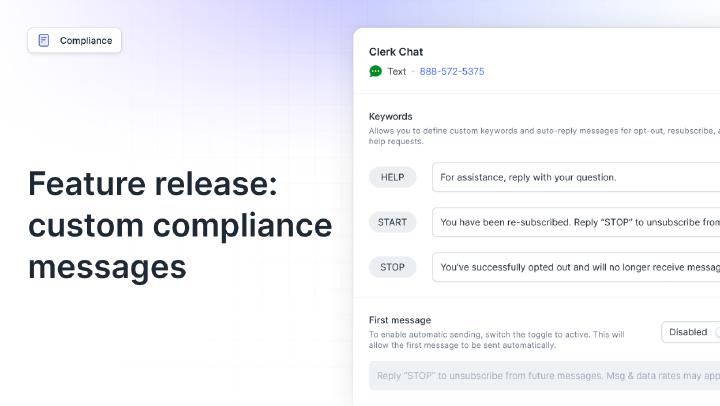10DLC vs Toll-Free vs Short Codes
By Team Clerk Chat
- Published: April 6, 2024
Free 10DLC Whitepaper
This article will examine the differences, advantages and disadvantages of three mass SMS messaging methods: 10-Digit Long Codes (10DLC), Toll-Free numbers and Short Codes, respectively. These are all application-to-person (A2P) solutions which are widely used in marketing and have various deliverability and reliability profiles, as well as different regulations surrounding their use.
Understanding 10DLC
Being able to send messages using a text messaging platform has revolutionized marketing and allows businesses to target customers more effectively and personally than ever before. It’s an opportunity to directly engage with customers, catering to their specific needs and interests.
What is 10DLC?
What is 10DLC? A 10-digit long code, or 10DLC, as it’s widely known, is a popular way for businesses to send mass text messages to customers. SMS messaging is one of the most trusted customer engagement methods, with 98% of messages being read, so it isn’t surprising that many companies favor this method of communication.
The Benefits of 10DLC
Ten Digit Long Codes look like standard telephone numbers, and this familiarity can mean that they are accepted more easily by consumers and are less likely to be marked as spam than some other methods, such as short codes. This can also establish that users are being contacted by a local number and immediately root your business in the local community.
The availability of SMS integrations such as Clerk Chat can help to provide 10DLC functionality across different applications and platforms such as Shopify, Salesforce and Outlook.
Use Cases for 10DLC
Some use cases for 10DLC include:
- The sending of promotional messages such as discounts and offers to existing customers.
- Reminders for appointments and reservations
- Customer satisfaction feedback surveys
Regulations and Compliance for 10DLC Messaging
Companies are required to identify themselves to carriers via brand registration. This can help reduce misuse as they are directly accountable and responsible for the actions taken on their account. Examples must be provided of the types of campaigns being run and the methods employed to acquire suitable opt-in permission from customers.
Exploring Toll-Free Numbers
Overview of Toll-Free Numbers
Toll-free numbers are those that are free to call, such as numbers that start with the 800 “area” code. Each toll-free number is prefaced with a three-digit code like this, which means it is free for a consumer to call it from a landline phone. They are often used in A2P by some of the larger and better-known companies and charities.
Advantages of Toll-Free Numbers
Using toll-free numbers can build trust because people generally see them as reliable and safe. Toll-free numbers support two-way communication so customers can respond directly to messaging. They also can handle a lot of messages at once and are less likely to be slowed down by service providers, in comparison to some other methods. It is possible to purchase a “vanity” number (customized) which spells out the company name if desired.
Applications of Toll-Free Numbers
Toll-free numbers are very commonly used in customer service because businesses can answer queries, address concerns and provide support via SMS. They are also often used for transactional messages and notifications such as order confirmations, shipping updates, and account alerts.
Cost Considerations and Limitations
Toll-free numbers can be more expensive than some of the other options depending on the package purchased and the volume of messages being transmitted through the system. They are also geographically specific, and this can cause problems or incur additional costs when dealing with international customers.
Short Codes Demystified
Definition and Functionality of Short Codes
Unlike 10DLC and Toll-Free Numbers, Short Codes usually have five or six digits and don’t resemble a traditional telephone number. They are known for being short and memorable and generating high user engagement rates.
Advantages and Limitations of Short Codes
The length of short codes can be both a blessing and a curse. On the one hand, they are distinctive and easier to remember than a ten-digit long code, and on the other hand, they are often dismissed as being spam. They are the fastest method of delivering A2P messaging, with a throughput of 500 messages per second.
Industry Applications of Short Codes
Short codes are often used in the provision of information services such as news headlines, weather updates and stock alerts. Customers can subscribe to different lists by texting a specific keyword to the short code. These can include premium subscriptions, which charge the end user per message received once they have subscribed. This is something that is often used by not-for-profit organizations and charities for fundraising activities.
Two-factor authentication (2FA) is often implemented using short codes, and this is becoming a popular security feature on social media, banking, and trading platforms.
Short Code Best Practices
It is essential that companies using short codes comply with laws such as the Telephone Consumer Protection Act (TCPA), which regulates the use of A2P services for commercial purposes.
These rules include obtaining verifiable consent, keeping accurate records, and meeting stringent content and delivery guidelines. Failure to comply could result in fines, not to mention your subscribers losing trust in your brand.
Businesses are also required to identify themselves using a recognizable sender ID and to offer the opportunity to opt out of receiving further messages.
Comparing 10DLC, Toll-Free, and Short Codes
Cost Analysis
The cost of each of the options depends on the volume of messages that you need to send, so it pays to understand your business needs and go from there when calculating costs. What are the costs of 10dlc vs toll-free? Generally, toll-free numbers and 10DLC are less expensive than short codes. However, when researching costs, look into throughput limits, registration, send rate, and carrier charges. It is also possible to reduce the costs of 10DLC carrier traffic by registering your traffic and undergoing the verification processes to prove that you aren’t spamming.
Delivery Speed and Reliability
Speed is measured by messages per second (MPS). The fastest delivery speeds are provided by short codes compared to the rates for Toll Free and 10DLC. This is for standard SMS, rather than MMS messages. It is possible to increase the delivery speeds using both Toll Free and 10DLC, but this requires a special case and often different pricing.
Compliance and Regulations
10DLC compliance is one of the largest reasons for the increasing popularity of this medium and why it is likely to be one of the most successful A2P platforms over the next decade and beyond. The mandatory brand registration creates accountability and reassurance, which is overwhelmingly supported by the public.
Use Cases Comparison
Toll free numbers are often used for customer service as their numbers can also be used to take voice calls and can accept incoming text messages. They are also often used for order confirmations, shipping updates, etc. because the number is verifiable and known to be that company’s contact. They are also often used if there is a security breach on a customer account.
10DLC vs short codes? 10DLC is often used for customer support and feedback, as the number is often one that is local to the customer and they are familiar with the area code. The two-way messaging functionality can also help with this. Appointment reminders, surveys, feedback, and transactional notifications are often issued using 10DLC. Short codes are not voice-capable but are available globally.
Short codes are often used for running competitions. Customers can enter by sending a particular phrase to the number. This is also widely used by charities to generate donations, as they can charge the customer a set amount to receive an SMS message. Often an advertisement in a newspaper will say “Donate $5 now by texting DONATE to [Shortcode number].” They are also widely used for Two-Factor authentication and providing information services such as stocks, sports, news, and weather reports.
Scalability and Customization Options
In terms of scalability, short codes have the most throughput and are the most sensible option for those who have a huge list of customers to reach when they have time-sensitive offers, and timely delivery is therefore important.
FAQs
What are the main differences between 10DLC, Toll-Free, and Short Codes?
There are differences in terms of brand recognition and customer reaction to each of the solutions.
Toll-Free numbers have a high trust rating because they are familiar national numbers, so this implies that the company using them is responsible.
10DLC numbers usually start with a local area code, which can make people from that area feel more trusting of the company. However, people from a different state or county might not recognize where the number is based.
Short codes have a five or six digit number, and even though it isn’t a traditional telephone number, it’s often easier to remember.
How do I choose between 10DLC, Toll-Free, and Short Codes for my business?
Which solution you choose depends on the use case that your business has. The different solutions are all suited to different aspects of A2P messaging, and this will have an effect on which you choose. Now there are more options than there were years ago, consider the best communication strategy for both your customers and your business.
Are there any compliance issues to consider when using these messaging solutions?
There are compliance issues with all of these, and it is important that you fully take these on board before proceeding. When using 10DLC, businesses are required to register their brand. The Campaign Registry (TCR) helps brands avoid additional carrier fees for non-registered messaging traffic.
What are the typical costs associated with 10DLC, Toll-Free, and Short Codes?
Short codes are often pricey, toll-free is usually more expensive than 10DLC, and 10DLC is usually the lowest cost per message. Regardless, each option has a number of costs attached to them, from monthly fees for the rental of the number to individual costs per SMS message sent or received. Take time to research.
How can I ensure the deliverability of messages with these solutions?
Short codes have the best record and the highest delivery records. There are many factors that will influence the level of delivery of your campaign, including sender reputation and regulatory compliance. Senders with a good reputation are far more likely to be able to get their messages delivered successfully. Messages that avoid spammy language are also far more likely to be delivered. If you provide valuable content to your end-users, you are far more likely to have your messages delivered and not flagged as spam. Choosing an SMS messaging platform such as Clerk Chat can also help to increase deliverability.
Choosing the Right Messaging Solution for your Business
Each of these solutions, toll-free, 10DLC, and short codes, offers opportunities for businesses to connect with their customers. However, deciding which one to use depends on factors like how it will be used, how much it costs, and what rules need to be followed. Also, keep in mind that some companies use all three channels, depending on need.
Toll-free numbers have nationwide recognition and trustworthiness, 10DLC numbers foster a sense of familiarity because of the local area codes, and short codes, though limited in voice capability, are scalable.
Evaluate your options, and you’ll be on your way to creating effective messaging strategies that resonate with your audience and drive meaningful engagement.
In this article:
Ready to use your business number for text messaging?
Thousands of businesses are already experiencing the power of conversational messaging through SMS. Join us. Free trial and paid tiers available.
Get Started#Subscribe
Get product updates in your inbox
Tutorials, features, and Clerk Chat news delivered straight to you.




